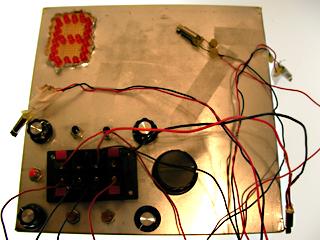CrudBox
Steven Litt
The CrudBox is a sequencer/drum machine which allows users to create and compose rhythmic electroacoustic music by manipulating motors and other physical objects and amplifying their sounds in real time.
http://colorforms.vox.com/library/posts/tags/physical+computing+studio/

Classes
Studio (Physical Computing)
Whereas every existing sequencer and drum machine before the CrudBox created sound electronically, using either 1) analog synthesis, in which sound is created by manipulating voltage in real time, or 2) prerecorded or preprogrammed digital sound, the CrudBox creates sound by recording, looping, and editing the actions of motors, solenoids, and virtually any other physical, mechanical object and then amplifying their sounds in real time. There is absolutely no recording of audio in the CrudBox. All the sounds are created acoustically in real time.
Audience
People who love both the freedom of making lots of noise and the regiment of rhythm, whether they realize it or not.
Implementation
The interface is currently house in a small, about 1.5" x 10" x 10", metal box I found in the garbage. I chose to use a metal box because I knew I was mostly going to be experimenting with the sounds of the motors on sheet metal, and so what could be simpler than contact mic-ing and attaching them to the instrument/interface itself?
The current CrudBox interface, which is built and runs smoothly, allows control over 4 motors. In addition to switching each motor on and off with its button, each one also has a pot with which you can set pulsewidth modulation on it to change the pitch of the sounds it produces by changing the speed at which it turns. There is also an erase button to remove the actions/sounds of a motor you've set, and a tempo pot to control the speed/length of the "loop" (the time at which the motor you just switched on and off will again robotically switch itself on and off). Each motor can be switched on and off up to 8 times over the course of each loop, each of the 8 times with its own pulsewidth modulation value.
The only big thing I'm looking to add by the end of the semester is a memory which can save up to 10 loops and allow the user to cycle through them. I have the code for this done, and I have a 7 segment LED and a rotary encoder set up so the user can cycle from 0 to 9. Right now it can only record 2 separate loops, but with some code tweaking I should be able to add a few more.
There are two other small things I'm going to add (at the advice of various user-testers): 1) an LED next to each motor on/off button which will light up when the motor is switched on, so its easier for a novice user to understand the connection between the buttons, the motors, and the sounds, and 2) a set of 4 LEDs in a line which will blink 1... 2... 3... 4... along with the current tempo for clarity.
Audience
People who love both the freedom of making lots of noise and the regiment of rhythm, whether they realize it or not.
Implementation
The interface is currently house in a small, about 1.5" x 10" x 10", metal box I found in the garbage. I chose to use a metal box because I knew I was mostly going to be experimenting with the sounds of the motors on sheet metal, and so what could be simpler than contact mic-ing and attaching them to the instrument/interface itself?
The current CrudBox interface, which is built and runs smoothly, allows control over 4 motors. In addition to switching each motor on and off with its button, each one also has a pot with which you can set pulsewidth modulation on it to change the pitch of the sounds it produces by changing the speed at which it turns. There is also an erase button to remove the actions/sounds of a motor you've set, and a tempo pot to control the speed/length of the "loop" (the time at which the motor you just switched on and off will again robotically switch itself on and off). Each motor can be switched on and off up to 8 times over the course of each loop, each of the 8 times with its own pulsewidth modulation value.
The only big thing I'm looking to add by the end of the semester is a memory which can save up to 10 loops and allow the user to cycle through them. I have the code for this done, and I have a 7 segment LED and a rotary encoder set up so the user can cycle from 0 to 9. Right now it can only record 2 separate loops, but with some code tweaking I should be able to add a few more.
There are two other small things I'm going to add (at the advice of various user-testers): 1) an LED next to each motor on/off button which will light up when the motor is switched on, so its easier for a novice user to understand the connection between the buttons, the motors, and the sounds, and 2) a set of 4 LEDs in a line which will blink 1... 2... 3... 4... along with the current tempo for clarity.